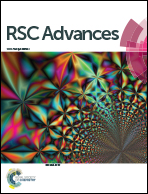Novel microlens arrays with embedded Al2O3 nanoparticles for enhancing efficiency and stability of flexible polymer light-emitting diodes†
Abstract
The use of polymer light-emitting diodes (PLEDs) as future displays and lightings has been of interest because of their advantages such as lightness, thinness, high contrast ratio, fast response time and high flexibility. Light-extraction structures such as microlens arrays have been designed to improve the efficiency of PLEDs. In this work, we have fabricated novel microlens arrays based on an organic–inorganic hybrid sol on a flexible substrate. Al2O3 nanoparticles dispersed in microlens arrays are expected not only to extract more light but also to block gas molecules. Further light-extraction from Al2O3 nanoparticles in the microlens arrays was confirmed by an increase in diffusive reflectance and photoluminescence intensity. As a result, the flexible PLEDs with the arrays showed enhanced maximum current efficiencies by 47% and 38% for SPB-02T (blue) and PDY-132 (yellow) emissive materials. They also showed improved stability, and high flexibility at a bending radius of 4 mm. Furthermore, Al2O3 nanoparticles were incorporated into irregular microlens arrays consisting of two different sizes of hemispherical lenses, to minimize changes in emission spectra and radiation pattern as well as to improve efficiency.


 Please wait while we load your content...
Please wait while we load your content...